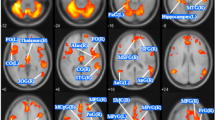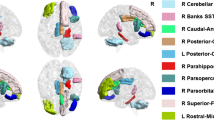Abstract
Objective
The objective of the present study is to evaluate cortical thickness (CT) abnormalities using FreeSurfer in adult subjects who had an onset of anorexia nervosa during their adolescence some 20 years previously, and to compare them with control subjects.
Methods
Fifty-four participants, including 26 women who were diagnosed and treated for AN during adolescence some 20 years previously and 28 healthy women of similar age and geographical area were assessed using structured interviews and MRI scans. Prior AN subjects were divided into two groups depending on their current eating disorder status (recovered or not recovered from any eating disorder). In all subjects, CT was measured using FreeSurfer.
Results
A significantly lower CT was observed in the eating disorder group than in the control group in the right post-central gyrus and the lateral occipital cortex. The recovered eating disorder group only had lower CT in the post-central gyrus. Within all subjects with prior AN, no correlations were found between lower CT in these areas and clinical variables.
Discussion
CT is reduced some 20 years after diagnosis of AN especially in the parietal and precentral areas, even in subjects without any current ED diagnosis.

Similar content being viewed by others
References
Papadopoulos FC, Ekbom A, Brandt L, Ekselius L (2009) Excess mortality, causes of death and prognostic factors in anorexia nervosa. Br J Psychiatry 194:10–17. https://doi.org/10.1192/bjp.bp.108.054742
Castro-Fornieles J, Bargalló N, Lázaro L et al (2009) A cross-sectional and follow-up voxel-based morphometric MRI study in adolescent anorexia nervosa. J Psychiatr Res 43:331–340. https://doi.org/10.1016/j.jpsychires.2008.03.013
Titova OE, Hjorth OC, Schiöth HB, Brooks SJ (2013) Anorexia nervosa is linked to reduced brain structure in reward and somatosensory regions: a meta-analysis of VBM studies. BMC Psychiatry 13:110. https://doi.org/10.1186/1471-244X-13-110
Fujisawa TX, Yatsuga C, Mabe H et al (2015) Anorexia nervosa during adolescence is associated with decreased gray matter volume in the inferior frontal gyrus. PLoS One 10:e0128548. https://doi.org/10.1371/journal.pone.0128548
Roberto CA, Mayer LES, Brickman AM et al (2011) Brain tissue volume changes following weight gain in adults with anorexia nervosa. Int J Eat Disord 44:406–411. https://doi.org/10.1002/eat.20840
Swayze VW, Andersen AE, Andreasen NC et al (2003) Brain tissue volume segmentation in patients with anorexia nervosa before and after weight normalization. Int J Eat Disord 33:33–44. https://doi.org/10.1002/eat.10111
Lázaro L, Andrés S, Calvo A et al (2013) Normal gray and white matter volume after weight restoration in adolescents with anorexia nervosa. Int J Eat Disord 46:841–848. https://doi.org/10.1002/eat.22161
Wagner A, Greer P, Bailer UF et al (2006) Normal brain tissue volumes after long-term recovery in anorexia and bulimia nervosa. Biol Psychiatry 59:291–293. https://doi.org/10.1016/j.biopsych.2005.06.014
Bang L, Rø Ø, Endestad T (2016) Normal gray matter volumes in women recovered from anorexia nervosa: a voxel-based morphometry study. BMC Psychiatry 16:144. https://doi.org/10.1186/s12888-016-0856-z
Chui HT, Christensen BK, Zipursky RB et al (2008) Cognitive function and brain structure in females with a history of adolescent-onset anorexia nervosa. Pediatrics 122:e426–e437. https://doi.org/10.1542/peds.2008-0170
Winkler AM, Kochunov P, Blangero J et al (2010) Cortical thickness or grey matter volume? The importance of selecting the phenotype for imaging genetics studies. NeuroImage 53:1135–1146. https://doi.org/10.1016/j.neuroimage.2009.12.028
Bär K-J, de la Cruz F, Berger S et al (2015) Structural and functional differences in the cingulate cortex relate to disease severity in anorexia nervosa. J Psychiatry Neurosci 40:269–279. https://doi.org/10.1503/jpn.140193
Fuglset TS, Endestad T, Hilland E et al (2016) Brain volumes and regional cortical thickness in young females with anorexia nervosa. BMC Psychiatry 16:404. https://doi.org/10.1186/s12888-016-1126-9
Lavagnino L, Amianto F, Mwangi B et al (2016) The relationship between cortical thickness and body mass index differs between women with anorexia nervosa and healthy controls. Psychiatry Res Neuroimaging 248:105–109. https://doi.org/10.1016/j.pscychresns.2016.01.002
King JA, Geisler D, Ritschel F et al (2015) Global cortical thinning in acute anorexia nervosa normalizes following long-term weight restoration. Biol Psychiatry 77:624–632. https://doi.org/10.1016/j.biopsych.2014.09.005
Bernardoni F, King JA, Geisler D et al (2016) Weight restoration therapy rapidly reverses cortical thinning in anorexia nervosa: a longitudinal study. NeuroImage 130:214–222. https://doi.org/10.1016/j.neuroimage.2016.02.003
First M, Spitzer R, Gibbon M, Willimans J (1997) Structured clinical interview for DSM-IV axis i disorders, clinician version (SCID-CV). American Psychiatric Press, Inc, Washington, DC
American Psychiatric Association (2013) Diagnostic and statistical manual of mental disorders, 5th edn. American Psychiatric Association, Washington, DC
Segal DL, Hersen M, Van Hasselt VB, Kabacoff RI, Roth L (1993) Reliability of diagnoses in older psychiatric patients using the structured clinical interview for DSM-III-R. J Psychopathol Behav Assess 15:347–356
Segal DL, Hersen M, Van Hasselt VB (1994) Reliability of the structured clinical interview for DSM-III-R: an evaluative review. Compr Psychiatry 35:316–327
Segal DL, Kabacoff RI, Hersen M, Van Hasselt VB, Ryan CF (1995) Update on the reliability of diagnosis in older psychiatric outpatients using the structured clinical interview for DSM-III-R. J Clin Gerospsychol 1:313–321
Strakowski SM, Tohen M, Stoll AL, Faedda GL, Mayer PV, Kolbrener ML et al (1993) Comorbidity in psychosis at first hospitalization. Am J Psychiatry 150:752–757
Strakowski SM, Keck PE Jr, Elroy SL, Lonczak HS, West SA (1995) Chronology of comorbid and principal syndromes in first-episode psychosis. Compr Psychiatry 36:106–112
Stukenberg KW, Dura JR, Kiecolt-Glaser JK (1990) Depression screening scale validation in an elderly, community dwelling population. Psychol Assess 2:134–138
Elder KA, Grilo CM (2007) The Spanish language version of the Eating Disorder Examination Questionnaire: comparison with the Spanish language version of the eating disorder examination and test–retest reliability. Behav Res Ther 45:1369–1377. https://doi.org/10.1016/j.brat.2006.08.012
Fairburn C, Cooper Z (1993) The eating disorder examination. In: Fairburn C, Wilson G (eds) Binge eating: nature, assessment and treatment. Guilford, New York, pp 317–360
Robles ME, Oberst UE, Sánchez-Planell L, Chamarro A (2006) Cross-cultural adaptation of the eating disorder examination into Spanish. Med Clin 127:734–735
Grilo CM, Lozano C, Elder KA (2005) Inter-rater and test-retest reliability of the Spanish language version of the eating disorder examination interview: clinical and research implications. J Psychiatr Pract 11:231–240
Belloch A, Cabedo E, Morillo C. LM y CC (2003) Diseño de un instrumento Resultados, para evaluar las creencias disfuncionales del trastorno obsesivo-compulsivo: Psicología, preliminares del Inventario de Creencias Obsesivas (ICO). Int J Clin Health 3:235–250
Dale AM, Fischl B, Sereno MI (1999) Cortical surface-based analysis. I. Segmentation and surface reconstruction. NeuroImage 9:179–194. https://doi.org/10.1006/nimg.1998.0395
Rosas HD, Liu AK, Hersch S et al (2002) Regional and progressive thinning of the cortical ribbon in Huntington’s disease. Neurology 58:695–701
Gaudio S, Nocchi F, Franchin T et al (2011) Gray matter decrease distribution in the early stages of anorexia nervosa restrictive type in adolescents. Psychiatry Res 191:24–30. https://doi.org/10.1016/j.pscychresns.2010.06.007
Nico D, Daprati E, Nighoghossian N et al (2010) The role of the right parietal lobe in anorexia nervosa. Psychol Med 40:1531–1539. https://doi.org/10.1017/S0033291709991851
Fuglset TS, Landrø NI, Reas DL, Rø Ø (2016) Functional brain alterations in anorexia nervosa: a scoping review. J Eat Disord 4:32. https://doi.org/10.1186/s40337-016-0118-y
Davidovic M, Karjalainen L, Starck G et al (2018) Abnormal brain processing of gentle touch in anorexia nervosa. Psychiatry Res Neuroimaging 281:53–60. https://doi.org/10.1016/j.pscychresns.2018.08.007
Gaudio S, Quattrocchi CC (2012) Neural basis of a multidimensional model of body image distortion in anorexia nervosa. Neurosci Biobehav Rev 36:1839–1847. https://doi.org/10.1016/j.neubiorev.2012.05.003
Acknowledgements
Study supported by the Women’s Institute, Ministry of Equality of Spain (Grant number 234/09).
Author information
Authors and Affiliations
Corresponding author
Ethics declarations
Conflict of interest
Josefina Castro-Fornieles, Elena de la Serna, Anna Calvo, José Pariente, Susana Andrés-Perpiña, Maria Teresa Plana, Sonia Romero, Miguel Gárriz, and Núria Bargalló, affirm that we have no conflicts of interest. Dr. Flamarique has received travel support from Shire and conference attendance support from Rovi.
Rights and permissions
About this article
Cite this article
Castro-Fornieles, J., de la Serna, E., Calvo, A. et al. Cortical thickness 20 years after diagnosis of anorexia nervosa during adolescence. Eur Arch Psychiatry Clin Neurosci 271, 1133–1139 (2021). https://doi.org/10.1007/s00406-019-00992-4
Received:
Accepted:
Published:
Issue Date:
DOI: https://doi.org/10.1007/s00406-019-00992-4




